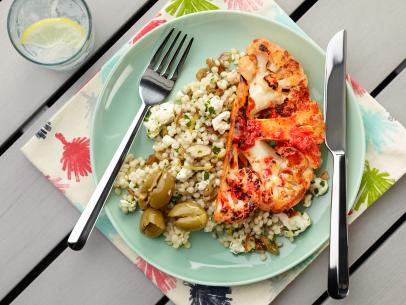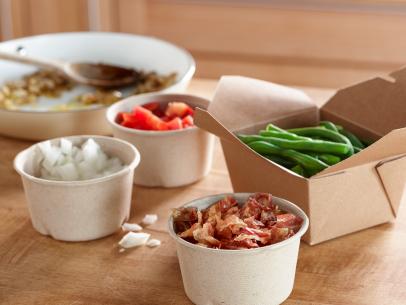
Recipe courtesy of
Nidhi Jalan
for
Food Network Kitchen
Recipe courtesy of
Nidhi Jalan
for
Food Network Kitchen
Watch how to make this recipe.
Rasmalai
Getting reviews...
- Level: Advanced
- Total: 5 hr (includes chilling, cooling and draining times)
- Active: 1 hr 50 min
- Yield: 6 servings (2 balls per serving)
-
- Nutritional Analysis
- Per Serving
- Serving Size
- 1 of 6 servings
- Calories
- 612
- Total Fat
- 20 g
- Saturated Fat
- 10 g
- Carbohydrates
- 94 g
- Dietary Fiber
- 1 g
- Sugar
- 93 g
- Protein
- 18 g
- Cholesterol
- 52 mg
- Sodium
- 224 mg
Rasmalai is a pillowy dessert consisting of freshly made balls of cottage cheese, called rasgullas, immersed in sweet saffron- and cardamom-flavored milk. It originated in the Eastern region of the Indian sub-continent. Garnished with nuts and sometimes fresh rose petals, it is one of the most delicate and regal desserts of India.
- Level: Advanced
- Total: 5 hr (includes chilling, cooling and draining times)
- Active: 1 hr 50 min
- Yield: 6 servings (2 balls per serving)
-
- Nutritional Analysis
- Per Serving
- Serving Size
- 1 of 6 servings
- Calories
- 612
- Total Fat
- 20 g
- Saturated Fat
- 10 g
- Carbohydrates
- 94 g
- Dietary Fiber
- 1 g
- Sugar
- 93 g
- Protein
- 18 g
- Cholesterol
- 52 mg
- Sodium
- 224 mg
Ingredients
Sauce (Ras):
Paneer Balls (Rasgullas):
Sugar Syrup:
Directions
- For the sauce (ras): Heat the milk over medium-high heat in a large, heavy-bottomed pot, stirring every minute or so in the beginning and more often as it comes closer to a boil to ensure that the milk doesn't burn at the bottom, until it comes to a boil, about 10 minutes. Reduce the heat to keep it at a medium boil and cook, stirring frequently, until the milk is reduced by half, 25 to 30 minutes.
- Meanwhile, combine the saffron strands with 1 tablespoon of the hot milk in a small bowl. Mash with the back of the spoon to get the saffron to release its color and turn the milk a deep orange.
- Once the milk has reduced, add the sugar, crushed cardamom and saffron-milk mixture and mix well. Cook, stirring as needed so the milk does not stick to the bottom of the pan, until the milk is well flavored, about 5 minutes. Add 3 tablespoons of the nuts, saving the balance for garnish, and let the milk mixture cool.
- For the paneer balls (rasgullas): Heat the milk over medium-high heat in a large, heavy-bottomed pot, stirring every minute or so in the beginning and more often as it comes closer to a boil to ensure that the milk doesn't burn at the bottom, until it comes to a boil, about 10 minutes.
- As soon as it reaches a boil, turn off the heat and add 1/2 cup of ice to reduce the temperature of the milk. Add the lemon or lime juice 1 tablespoon at a time until the milk is curdled and the solids separate from the whey. The whey will turn greenish-yellow. Add another 1/2 cup of ice. This stops the cooking and keeps the paneer soft.
- Line a strainer with folded-over cheesecloth or muslin and set over a large bowl. Pour the mixture into the strainer and let the water drain out. Pour a cup of cold water over the paneer and drain. Take the ends of the cloth and squeeze out the excess water very well. Hang the cloth to further drain out water from the paneer for about 30 minutes. The paneer should be crumbly yet a little moist.
- Add the paneer to a food processer and process until the crumbles become a ball, about 30 seconds. Alternatively, you can knead it with the heel of your palm, but this will take 10 to 15 minutes.
- Roll the dough into 12 equal balls, making sure there are no cracks. (A kitchen scale isn’t necessary but is helpful.) You can keep them round or gently flatten them out to disks about 1 inch high. If you see any cracks, smooth them over with wet fingers. Cover with a damp cloth.
- For the sugar syrup: Combine the sugar and 7 cups water in a wide Dutch oven and bring to a rolling boil. Add the prepared paneer balls one by one so the temperature doesn’t drop suddenly. Gently shake the pot, lower the heat slightly to keep the mixture at a low boil, cover and cook for 10 minutes. Do not open the lid in between. Gently stir the balls, cover and cook for another 5 minutes. The balls should almost double in size. Remove the pot from the heat and let it cool naturally, 20 to 30 minutes. The balls will sink in the water.
- Once cooled, drain the balls. Very gently squeeze out the syrup from the balls and transfer them to the prepared ras (saffron milk). Refrigerate for a minimum of 3 hours, to let the balls absorb the milk and become divine! Garnish with the reserved nuts and serve cold.
Cook’s Note
Making the rasgullas is the trickiest part of this recipe. At homes in India, people often buy ready-made rasgullas or rosogollas and make rasmalai with that. It’s a great shortcut. Often these rasgullas tend to be very sweet, so drain them, give them a dunk in plain water and gently squeeze out the liquid before transferring them to the prepared ras (saffron milk).
































